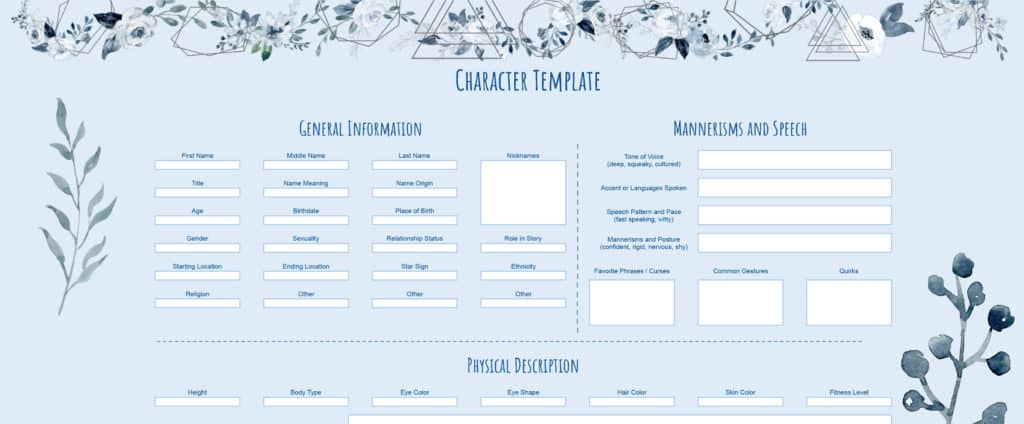
Drop whatever you’re doing as quickly as you can! (Unless you’re a surgeon carrying out a life-saving operation on a patient, then carry on and don’t let me stop you). I’ve got a new post for you, and it’s all about how to build a strong character for both the screen and the page.
So all you budding readers, screenwriters, and novelists, lend me your ears (not literally, of course… unless you know a good surgeon).
Here we go!
What makes a well-developed character?
In order to create a well-developed character, they require:
•A full-fledged backstory
•Personality traits that make them feel more, for want of a better word, personal to readers.
•A complex nature, so they aren’t rendered as one-dimensional.
While you might think creating a strong, well-developed, and layered character might sound difficult now, it’ll all come together once you’ve begun imagining your character as a real person and get comfortable thinking of them as a flesh and blood person. Boom, half your job is done!
An easy way to create a realistic character is to build a character profile. We at Adore Stories have created a free character profile template that you can use just check out our tools page and download it today! Filling out a character template can help you specify all the small details to help bring your character to life in a realistic way.

Now for the other half of it….
In order to create a well-developed character, first, we’ll have to figure out the different types of characters. These can vary from:
- The protagonist, i.e. The main one
- The antagonist, i.e. The problematic one who’s usually plotting against the main one
- Secondary, i.e Minor one/supporting character/best friend/love interest
- Static, i.e. The deadpan one who at times comes into play in a surprising twist
- Foil, i.e. Usually the square man to a slapstick, quirky character who tolerates them)
- The dynamic or round character, i.e Constantly developing and learning as a character.
Elements to build the perfect backstory
For a character to appear real to the reader or viewer, they need to have either one of the following or all of the following:
- Phobias
- Interests
- Quirks
- Fears
- Their past
- Their influences
- Childhood (good, bad, raised by a single parent, raised themselves, orphaned, traumatic, etc)
- Strengths and weaknesses (can be an asset as well as downfall)
- Nervous tics/habits (anxious pacing, chewing on a pencil, tapping palm incessantly on the table)
All these and more are needed to shape your character’s personality, character arc (a character’s emotional or physical journey), present or future motives, and even drive the plot.
More points to remember:
- Make each character distinctive and stand out as an individual. This makes it easy for readers and viewers to distinguish between characters themselves and easier for them to visualize how the fictional character would turn out if they existed in real life.
- An example: The terrific trio of Ron, Hermione, and Harry in the Harry Potter series. They all have unique traits and vast character differences as they grow up. As they say, with age comes great wisdom and responsibility. Harry goes from being a bespectacled helpless boy to a brave boy wizard, Hermione is the brains of the group, and Ron is a goofy redhead who gradually transforms from a scaredy-cat to a full-on strategic badass by the final book.
- Give each character an identifiable trait, a wide variety of personalities, bring their psyche or aftermath of a certain trauma into play much later to show that history can repeat itself or the character finds it hard to let go of their past. This can be the crux or heart of a character.
- Use secondary and minor characters to create conflict or as a foil/crutch for the main character/protagonist.
- Strong characters need a strong voice (and I don’t just mean a funky catchphrase).
Avoid these at all costs
- A perfect character is not equal to a loveable character. Even the seemingly nicest or sweetest people have flaws and are thus relatable to an audience. E.g. That kind and jolly neighbor who brings you freshly baked cookies every evening might have ulterior motives, or brace yourselves, might even be a well-disguised serial killer!
- Overusing stereotypes or creating an overly caricaturish character is more harmful than helpful and can even make your work feel dated. Unless the character you’re writing is like Johnny Lawrence from the Karate Kid spinoff ‘Cobra Kai’ who is gradually learning from his mistakes and trying not to be a bully and man-child who’s perpetually stuck in the 80s, try to avoid caricatures/stereotypes that will hinder progress of the character rather than act as a part of the arc of a character.
- Complicated motives might make you seem clever, but unless you can handle filling in plot holes, make the characters’ motives as clear, well defined, and as easy to understand/believe as possible. Or you’ll end up with a messy plot that’s all over the place!
With that, we’ve come to the end of this post. As usual, do feel free to share this with your fellow budding writers and literature nerds!



